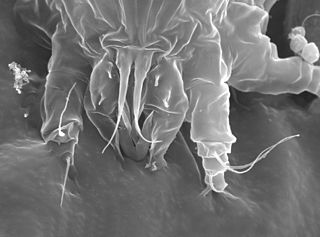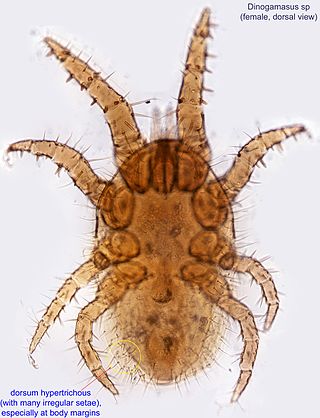
Mites are small arachnids. Mites span two large orders of arachnids, the Acariformes and the Parasitiformes, which were historically grouped together in the subclass Acari, but genetic analysis does not show clear evidence of a close relationship.

Varroa is a genus of parasitic mesostigmatan mites associated with honey bees, placed in its own family, Varroidae. The genus was named for Marcus Terentius Varro, a Roman scholar and beekeeper. The condition of a honeybee colony being infested with Varroa mites is called varroosis.
Acariasis is an infestation with mites.

Tarsonemidae is a family of mites, also called thread-footed mites or white mites.

An acarinarium is a specialized anatomical structure which is evolved to facilitate the retention of mites on the body of an organism, typically a bee or a wasp. The term was introduced by Walter Karl Johann Roepke.

Tydeus is a genus of mites belonging to the family Tydeidae. These are small, usually white, mites with soft bodies covered in striations and each leg terminating in two claws.

Eriophyoidea are a superfamily of herbivorous mites. All post-embryonic instars lack the third and fourth pairs of legs, and the respiratory system is also absent.
The Raphignathoidea is a superfamily of the Acari (mite) order Trombidiformes, comprising 1087 species in 62 genera and 12 families.

Rhizoglyphus is a genus of mites in the family Acaridae. It has a worldwide distribution and is often associated with the bulbs, corms or tubers of plants.
The family Ameroseiidae is one of the three families of mites under the superfamily Ascoidea. There are about 12 genera and more than 130 described species in Ameroseiidae. The family has a worldwide distribution.
Ascidae is a family of mites in the order Mesostigmata.

Dinogamasus is a genus of mites in the family Laelapidae. Most species are associated with carpenter bees in the genus Xylocopa and are found in their acarinarium.
Acarophenacidae is a family of mites in the order Trombidiformes that are egg parasitoids and ectoparasites of beetles or thrips. It contains eight genera and around 40 species.

Bryobia is a genus of mites in the spider mite family, Tetranychidae. The taxonomy of the genus is difficult. The genus has been revised several times. It is difficult to distinguish these tiny species from each other on the basis of morphological characters, and there is little agreement on which characteristics are of importance. Also, species can be variable in morphology. Over 130 species have been described, but many of the names are likely synonyms.

Blattisociidae is a family of mites in the order Mesostigmata.

Chaetodactylus krombeini,, was described by Karl Krombein and E. W. Baker in the 1960s. The mites are about 0.5 mm across, with the females larger than the males. Pollen mites are a kleptoparasitic pest of Megachilid solitary bees, with Ch. krombeini found with Osmia lignaria of North America,. Pollen mites do not feed on bees, but rather their provisions, and are harmful because they consume the food resources and starve or stunt the developing larvae; there is evidence that pollen mites also directly harm the egg by puncturing it.

Roubikia is a genus of bee-associated mites occurring in the neotropics. They are mutualists or commensals, and feed on fatty acids from floral oils and most likely on fungi. The type species is Chaetodactylus panamensis.
Melicharidae is a family of mites in the order Mesostigmata.
Mercedes Delfinado is an acarologist from the Philippines, who was a recipient of a 1962 Guggenheim Fellowship. She is a speciliast in bee mites, and published widely on insects of south-east Asia. For over twenty years she was a Chief Editor for the International Journal of Acarology. Multiple species were named in her honour.












